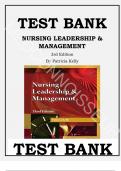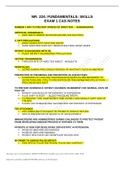TEST BANK NURSING LEADERSHIP & MANAGEMENT 3rd Edition By Patricia Kelly TEST BANK MEDCONNOISSEUR Nursing Leadership & Management 3rd Edition by Patricia Kelly Test Bank Table of Contents : Unit I: NURSING LEADERSHIP AND MANAGEMENT. Chapter 1. Nursing Leadership and Management. Chapter 2. The Healthcare Environment. Chapter 3. Organizational Behavior and Magnet Hospitals. Chapter 4. Basic Cli nical Healthcare Economics. Chapter 5. Evidence -Based Health Care. Chapter 6. Nursing and Healthcare Informatics. Chapter 7. Population Based Healthcare Practice. Unit II: LEADERSHIP AND MANAGEMENT OF THE INTERDISCIPLINARY TEAM. Chapter 8. Personal and Interdisciplinary Communication. Chapter 9. Politics and Consumer Partnerships. Chapter 10. Strategic Planning and organizing Patient Care. Chapter 11. Effective Team Building. Chapter 12. Power. Chapter 13. Change, Innovation, and Conflict Management. Unit III: LEADERSHIP AND MANAGEMENT OF PATIENT - CENTERED CARE. Chapter 14. Budget Conc epts for Patient Care. Chapter 15. Effective Staffing. Chapter 16. Delegation of Patient Care. Chapter 17. Organization of Patient Care Management. Chapter 18. Time Management and Setting Patient Care Priorities. Chapter 19. Patient and Health Care Education. Unit IV: QUALITY IMPROVEMENT OF PATI ENT OUTCOMES. Chapter 20. Managing Outcomes Using an Organizational Quality Improvement Model. Chapter 21. Evidence Based Strategies to Improve Patient Care Outcomes. Chapter 22. Decision Making and Critical Thinking. Chapter 23. Legal Aspects of Health Care. Chapter 24. Ethical Aspects of Healt h Care. Chapter 25. Culture, Generational Differences, and Spirituality. Unit V: LEADERSHIP AND MANAGEMENT OF SELF AND THE FUTURE. Chapter 26. Collective Bargaining. Chapter 27. Career Planning. Chapter 28. Nursing Job Opportunities. Chapter 29. Your First Job. Chapter 30. Healthy Living: Balancing Pers onal and Professional Needs. Chapter 31. NCLEX Preparation and Professionalism . MEDCONNOISSEUR Chapter 1: Nursing Leadership and Management MULTIPLE CHOICE 1. According to Henri Fayol, the functions of planning, organizing, coordinating, and controlling are considered which aspect of management? a.Roles b.Process c.Functions
d.Taxonomy ANS: B, The management process includes planning, organizing, coordinating, and controlling. Management roles include information processing, interpersonal relationships, and decision making. Management functions include planning, organizing, staffing, directing, coordinating, reporting, and budgeting. A taxonomy is a system that orders principles into a grouping or classification. 2. Which of the following is considered a decisional managerial role? a.Disseminator b.Figurehead c.Leader
d.Entrepreneur ANS: D, The decisional managerial roles include entrepreneur, disturbance handler, allocator of resources, and negotiator. The information processing managerial roles include monitor, disseminator, and spokesperson. The interpersonal managerial roles include figurehead, leader, and liaison. 3. A nurse manager meets regularly with other nurse managers, participates on the organizations committees, and attends meetings sponsored by professional organizations in order to manage relationships. These activities are considered which function of a manager? a.Informing b.Problem solving
c.Monitoring
d.Networking ANS: D, The role functions to manage relationships are networking, supporting, developing and mentoring, managing conflict and team building, motivating and inspiring, recognizing, and rewarding. The role functions to manage the work are planning and
organizing, problem solving, clarifying roles and objectives, informing, monitoring, consulting, and delegating. 4. A nurse was recently promoted to a middle-level manager position. The nurses title would most likely be which of the following? a.First-line manager b.Director c.Vice president of patient care services
d.Chief nurse executive ANS: B, A middle-level manager is called a director. A low managerial- level job is called the first-line manager. A nurse in an executive level role is called a chief nurse executive or vice president of patient care services. 5. A nurse manager who uses Frederick Taylors scientific management approach, would most likely focus on which of the following? MEDCONNOISSEUR a.General principles
b.Positional authority c.Labor productivity
d.Impersonal relations ANS: C, The area of focus for scientific management is labor productivity. In bureaucratic theory, efficiency is achieved through impersonal relations within a formal structure and is based on positional authority. Administrative principle theory consists of principles of management that are relevant to any organization. 6. According to Vrooms Theory of Motivation, force: a.is the perceived possibility that the goal will be achieved. b.describes the amount of effort one will exert to reach ones goal. c.describes people who have free will but choose to comply with orders they are given. d.is a naturally forming social group that can become a contributor to an organization. ANS: B, According to Vrooms Theory of Motivation, Force describes the amount of effort one will exert to reach ones goal. Valence speaks to the level of attractiveness or unattractiveness of the goal. Expectancy is the perceived possibility that the goal will be achieved. Vrooms Theory of Motivation can be demonstrated in the form of an equation: Force = Valence Expectancy (Vroom, 1964). The theory proposes that this equation can help to predict the motivation, or force, of an individual as described by Vroom. 7. According to R. N. Lussier, motivation: a.is unconsciously demonstrated by people. b.occurs externally to influence behavior. c.is determined by others choices. d.occurs internally to influence behavior. ANS: D, Motivation is a process that occurs internally to influence and direct our behavior in order to satisfy needs. Motivation is
not explicitly demonstrated by people, but rather it is interpreted from their behavior. Motivation is whatever influences our choices and creates direction, intensity, and persistence in our behavior. 8. According to R. N. Lussier, there are content motivation theories and process motivation theories.
Which of the following is considered a process motivation theory? a.Equity theory b.Hierarchy of needs theory c.Existence-relatedness-growth theory d.Hygiene maintenance and motivation factors ANS: A, The process motivation theories are equity theory and expectancy theory. The content motivation theories include Maslows hierarchy of needs theory, Aldefers existence- relatedness-growth (ERG) theory, and Herzbergs hygiene maintenance factors and motivation factors. 9. The theory that includes maintenance and motivation factors is: a.Maslows hierarchy of needs. b.Herzbergs two-factor theory. c.McGregors theory X and theory Y . d.Ouchis theory Z. MEDCONNOISSEUR





